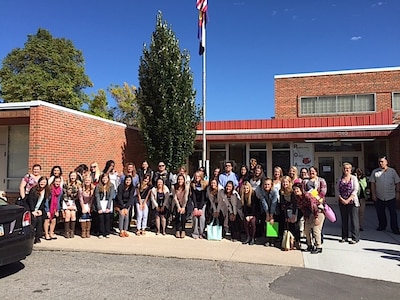Shaundra Johns grew up in Aurora and worked for 11 years in metro Denver, but long imagined herself teaching in a rural community. She wanted the family feeling of a small town, the flexibility of a school district with less bureaucracy, and someday to own a goat.
That’s why the 29-year-old Metro State University student traveled last month from her home in Littleton to La Veta in southern Colorado for a three-day immersion experience for prospective rural teachers.
Johns and seven other participants, some still in school and some considering career changes, toured the town, met with district staff and students, and helped with floats for the district’s homecoming parade. One evening, they gathered with leaders of the 225-student district to eat dinner at Frankie’s Steak and Seafood, the nicest restaurant in town.
“I fell in love,” Johns said.
With many of Colorado’s rural school districts locked in a perennial struggle to fill teaching jobs, those four words are exactly what district administrators and organizers of the immersion trip want to hear.
In fact, introducing current and future teachers to the realities of rural teaching was precisely the point of the all-expenses-paid trip. It was part of a three-trip series organized by Colorado State University Pueblo and several partners, inspired by a similar teacher recruitment program used in Alaska.

The immersion trips, launched last spring with a trip to the 548-student Huerfano district, and wrapping up later this month with one to the 133-student Manzanola district, are among a raft of recent initiatives aimed at beefing up rural teacher recruitment and retention in Colorado.
Other efforts include day-long bus trips to rural districts for students in teacher preparation programs, stipends for student teachers in rural districts and for rural teachers who want additional training, and “teacher cadet” programs to get rural high school students interested in teaching careers.
Teacher supply and demand in the U.S. is very much a local story, with some areas doing better than others. As the economy has improved and enrollment in traditional teacher preparation programs has declined, both urban and rural districts have reported struggles to find qualified teachers.
Much of the work around rural teacher recruitment is taking place at the school or district level, or in partnership with teacher preparation programs, according to a June report from the Denver-based Education Commission of the States, which tracks policy shifts and research.
A few other states in addition to Colorado have invested in the issue. In Minnesota, a new grant program provides student teaching stipends for low-income students and grants for licensed teachers who agree to teach in regions struggling to find qualified applicants. Mississippi introduced a loan repayment for teachers meeting certain qualifications who choose teach in geographic areas facing a shortage.
Last winter, Western State Colorado University hired Megan Quitter to be the state’s first rural education outreach coordinator. She serves as a connector of sorts between Colorado’s 147 rural districts and teacher preparation programs across the state.
Quitter’s position and the rural teacher immersion trips are paid for with federal grant money. Some of the other rural education initiatives are funded with $441,000 approved by the state legislature last spring.

Robert Mitchell, academic policy officer for teacher preparation at the Colorado Department of Higher Education, said the burst of recent rural education efforts helps, but represents only a short-term solution.
“There’s just a teacher shortage, period,” he said, noting a 30 percent decline in the number of college students attending teacher preparation programs in Colorado over the last six years.
“Any given year when people are looking for elementary teachers, there’s a good chance our rural districts will get zero applications for those jobs,” Mitchell said.
Still, he believes some of the best teaching in the state happens in rural communities, owing to their smaller, more intimate classrooms and willingness to experiment.
“Rural Colorado is the best-kept secret that we have,” Mitchell said.
Convincing a skeptic
When La Veta Superintendent Bree Lessar first heard the idea for the rural teacher immersion program, she thought it was ridiculous.
“I just really couldn’t see it working,” she said. “You’re going to bring in a dozen people from somewhere and make them have sleepovers?”
But the more Lessar thought about it, the more it made sense — especially since a grant would cover the costs. She knew it was important for prospective teachers to visit in person because small-town living isn’t for everyone.
One candidate she’d hired after an interview over Skype didn’t make it through the first year. Teacher fairs weren’t particularly effective, either, yielding just one or two hires in eight years.
Lessar, who grew up in rural Wyoming, has plenty of eventual vacancies to think about in her district. Seven of her 21 teachers are officially retired but work limited hours or will soon because of state retirement rules. The openings may be two or three years out, but she knows she needs to plan carefully to find a good fit.
Take the high school science teacher who has helped steer four of La Veta’s graduates to medical school over the last several years. Lessar wants the replacement to spend a year in the classroom with that teacher before she departs.
Overall, Lessar believes the immersion program was successful and with some tweaks could be a promising recruitment strategy. About half the participants expressed interest in officially applying, she said.
No sugarcoating
While immersion experiences like the one in La Veta are a chance for districts officials to highlight the benefits of the rural lifestyle — lower cost of living, close-knit communities and flexibility in the classroom — they are also frank about the downsides.

The dating pool is limited, housing is tricky in some communities and most of all, starting salaries are low.
In La Veta, base pay is $31,000. Mitchell said in some rural districts, it’s $25,000.
Money was the deal-breaker for Graham Carpenter, who went on the trip to La Veta. The 32-year-old Fort Collins resident runs a residential real estate company and applied to participate because his girlfriend at the time was exploring rural nursing.
Carpenter described the experience as “first-class,” but said at this stage in his life he can’t live on the salary.
“The pay is just killer,” he said. “Nobody in their right mind is going to take a pay cut or leave the Front Range to go down there.”
But asked if the opportunity would be more appealing if he was 22 and not 32, he said, “Yes, if I didn’t own property and I was younger, it probably would have made a difference.”
Johns, who barely cleared $25,000 a year working in child care centers, had a little different take on La Veta’s base salary.
“It’s not bad per se. It’s not great either,” she said. “You don’t go into education for the money.”
Still, state leaders believe mediocre pay is a big reason why fewer college students are seeking teaching degrees these days, a trend hurting districts of all sizes.
“If we could pay all our teachers $65,000 a year, my problems go away,” Mitchell said.

